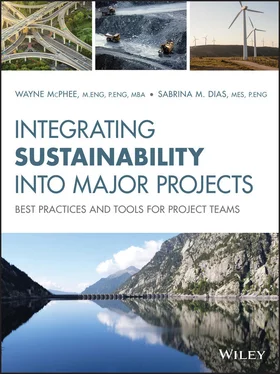It is important to understand that sustainability should not be a standalone discipline off to the side, separated from the rest of the project organization. Rather, sustainability must be integral to every aspect of project delivery. We have made every effort to demonstrate how sustainability is a team sport where everyone on the project team contributes.
This book will lead project teams through the various types of major projects, explain how sustainability can be integrated into traditional project management functions, and demonstrate how sustainability can play a critical role throughout the project lifecycle.
There are many ways to describe the integration of environmental, social, and economic development challenges and opportunities into a project. Here are some of the most common terms:
Sustainability
Sustainable development
Responsible development
Corporate citizenship
Corporate social responsibility
Creating shared value
Although there are subtle differences in definition, all of the terms are basically capturing the same concepts. This book uses the term “sustainability,” but project teams can and should use whatever terminology allows them to create a better project. If your organization or industry primarily uses other terminology, then it is best to stick with what is familiar and accepted. Managing sustainability on major projects is hard enough without trying to introduce new terminology to your organization or industry.
DEFINITION: SUSTAINABILITY
We cannot discuss sustainability for major projects without clarifying what we mean by the term. We use “sustainability” as the shortened version of “sustainable development,” a term classically defined by the World Commission on Environment and Development:
Sustainable development is development that meets the needs of the present without compromising the ability of future generations to meet their own needs.
1.2 Creating Value by Integrating Sustainability
Value creation on major projects is traditionally assessed by a strict financial analysis: Was the project delivered on-budget? These days, most organizations and financial institutions are evolving how they see “value.” And they are now incorporating concepts of brand and reputation, risk minimization, and responsible investing into the evaluation of an organization's or project's success.
Project sustainability efforts are often seen as an additional cost, a negative line item on the project budget. If managed properly, however, sustainability becomes a critical component of creating value out of the project.
Sustainability programs can:
Drive innovation that can reduce overall project costs.
Reduce the risk of project delays that can increase budgets and delay revenue generation from the finished project.
Help secure and maintain community support that can streamline approvals.
Reduce project risks, which can improve access to capital and lower financing costs.
Create a better, more attractive project that draws potential buyers and increases project valuation.
One of the most powerful tools to gain executive-level support for integrating sustainability into major projects is to demonstrate how sustainability can have a positive impact on project financing. This is true for industrial projects that rely on stocks, bonds, and debt financing, as well as government projects where financing could come from project-specific bonds, green bonds, or financing strategies like public-private partnerships (P3s). A strong sustainability program will help improve the project's access to capital, reduce the cost of borrowing money, and improve overall project profitability. Studies have shown that industrial firms “with better sustainability who disclosed their strategies to pivotal stakeholders enjoyed higher stakeholder trust and lower capital access restraints.” 1
Globally, financial institutions have recognized that one of the largest risks for major projects is environmental, social, and governance (ESG) risks and this has led to the adoption of standards for sustainability and ESG management. Financial institutions often perform extensive due diligence prior to providing capital to develop a project. It is now becoming increasingly common for institutions to require an ESG review as part of due diligence and to include regular audits after financing has been approved. This helps to ensure that ESG commitments are being met and that project risks are being managed on an ongoing basis.
A strong sustainability program and project team is essential to addressing ESG risks and providing concrete evidence to financial institutions and their auditors that these risks are being managed. A traditional view of projects may see sustainability and environmental programs as an unnecessary cost or an annoying delay in getting construction started. But most projects require outside financing, and with financial institutions requiring strong risk and sustainability management before making an investment, a well-integrated sustainability program is essential for many projects to proceed.
Many projects (resource extraction projects, in particular) are developed with the intent of selling the asset once it has been built and commissioned. Whether the acquiring organization is a larger organization, a pension fund, or a stock market investor, the project will need to demonstrate that there is strong community support for the project and that environmental and social risks are being managed effectively.
Project teams should develop their sustainability program not just to meet the minimum needs of local approvals, but also to consider how the sustainability program will fit with the requirements of the potential future owners. Like most elements of good project management, it is better to structure the project correctly at the beginning than it is to try to fix it at the end.
Developing Future Projects
Whether the organization is considering a future expansion to the current project or developing other projects in the future, it is critical to maintain a strong reputation and build community support. With the expansion of social media to all corners of the world, issues at one site can damage the ability of the organization to pursue projects at new locations. Communities located near a new project site might not know the organization but can quickly find out how they have performed on other projects. With this knowledge they can take action either to protect their community by blocking the new project or to welcome an organization that has proven it can develop sustainable projects.
A strong sustainability program can ensure that the project helps the organization build credibility and a reputation to support the success of the current project and to ensure that the organization is well-prepared for future projects.
Integrating sustainability into project planning and engaging with local stakeholders can help the team understand design constraints and potential issues early in the project development, which can avoid rework and redesign later in the project. People who live and work in the area of the proposed site can help the project team understand the context of the local area, local regulatory requirements, and potential social and environmental impacts. Engaging with local communities can help the team get a sense of whether the project will be supported and, if not, how they can revise and improve the design and development plans early in the project. Engaging with local communities can also create value by accessing local knowledge that can be used to improve designs and reduce costs.
Читать дальше












